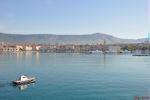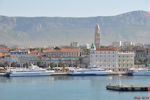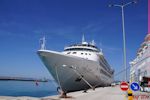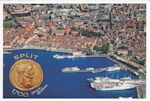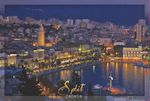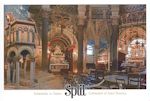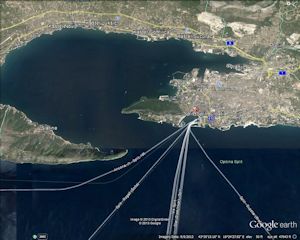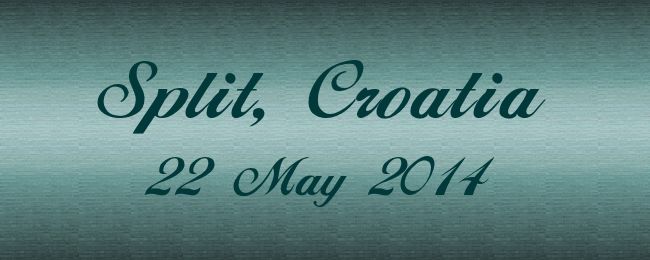
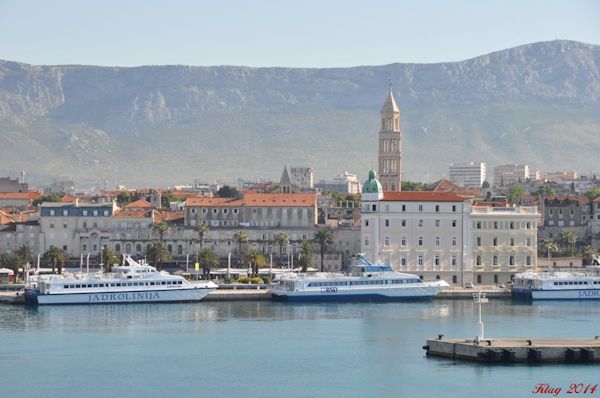
Photo by R Klug
Links to Port Pages
Split, Croatia
We arrived in Split, Croatia about 9:00 am the morning of the 22nd. After a late breakfast we wandered off the ship and down the road to Diocletian's Palace.
This former palace is a true mix of the old and new, sidewalk cafes next to the bell tower of the cathedral; elite shops and souvenirs in the lower levels of underground quarters; new construction mixed with old rubble.
We took the tour through the Cathedral of St Domnius. The palace was built at the end of the 3rd century. In the center of the palace stands the Emperor's Mausoleum. In front of that the cathedral was constructed in the 7th century. There is quite a history of the persecution and deaths of Christians by Diocletian. After construction of the church the Catholics buried the bones and relics of the martyrs in the mausoleum and consecrated the church.
After a cappuccino at the outdoor cafe Luxor, in the shadow of the bell tower, we explored the rest of the palace area and then out into the area surrounding the palace. Very modern constructino on one side of a street, ancient on the other. From the postcard and reconstruction view of the palace there appeared to be no waterfront. Today, a promenade of stores and wide pavements with trees and benches line the waterfront.
We returned to the ship and met up with David and Lynn for dinner at the pool grill - "Hot Rocks", our favorite. The evening was beautiful and we watched the lights of Split as we sailed away and on our way to our second visit of Dubrovnik.
Arriving to Split |
Split, Croatia |
Silver Wind docked in Split |
View to peristyle - There was an enactment occuring |
St Domnius Tower |
Luxor Cafe where we had cappuccino |
Randy in front of the Silver (East) Gate |
Inside Split |
Steps |
Street and cafe and waiter |
Street and cafe |
Waterfront - Split, Croatia |
Postcard of Split
|
Postcard of Diocletian's Palace |
Postcard of Split at night |
Postcard of St Domnius Interior |
![]()
Pre-cruise Posts
 |
 |
Koper (Italian: Capodistria; Croatian: Kopar) is a city in southwestern Slovenia, with the other Slovenian coastal towns Ankaran, Izola, Piran, and Portorož, situated along the country's 47-kilometre (29-mile) coastline, approximately five kilometres (3.1 miles) from its border with Italy. Having a unique ecology and biodiversity, it is considered an important national natural resource. With only one percent of Slovenia having a coastline, the influence that the city's Port of Koper, which is also the major contributor to the economy of the eponymous city municipality, has on tourism was a factor in deciding Ankaran to leave the municipality. Koper is the main urban center of the Slovenian Istria with a population of about 25,000.
The city of Koper is officially bilingual, with both Slovene and Italian as official languages. Sights in Koper include the 15th-century Praetorian Palace and Loggia in Venetian Gothic style, the 12th century Carmine Rotunda church, and the Cathedral of St Nazarius, with its 14th-century tower.
Koper is also one of the main road entry points into Slovenia from Italy, which lies to the north of the municipality. The main motorway crossing is at Spodnje Škofije to the north of the city of Koper. The motorway continues into Rabuiese and Trieste. Koper also has a rail connection with the capital city, Ljubljana. On the coast, there is a crossing at Lazaret into Lazaretto in Muggia municipality in Trieste province. The Italian border crossing is known as San Bartolomeo. (From Wikipedia)
From Silversea website: Just half the size of Switzerland, Slovenia is often bypassed in favor of more well-known countries such as Croatia and Italy. The country's relative obscurity owes much to its history. From Roman times to nearly the present day, Slovenian territory was incorporated into far-larger empires, relegating Slovenia through the ages to the role of rustic, if charming, hinterland. Backed by hills planted with olive groves and vineyards, Slovenia's small strip of Adriatic coastline is only 47 km (29 miles) long and dominated by the towns of Koper, Izola, Piran, and Portorož. Following centuries of Venetian rule, the coast remains culturally and spiritually connected to Italy, and Italian is still widely spoken. Koper, Slovenia's largest port, and Izola, its biggest fishery, are workaday towns that nevertheless retain a lot of historical charm. The medieval port of Piran is a gem and a must-see. Its Venetian core is nearly perfectly preserved. The most unspoiled stretch of coast is at the Strunjan Nature Reserve-which also has an area reserved for nudists-between Piran and Izola.
![]()
What We Plan to See:
Split is another fantastic place to visit as it was built centered around the Roman Emperor Diocletian's Palace. The palace was constructed in 305 AD, but archaeological research dates the area back to the Greeks as a colony named Aspálathos in 6th century BC, maybe older.
While exploring the town is a must, key sites to see are the Archaeological Museum, Diocletian's Palace, and the Cathedral of St Duje.
![]()
